ESP FIAT DUCATO 2006 Owner handbook (in English)
[x] Cancel search | Manufacturer: FIAT, Model Year: 2006, Model line: DUCATO, Model: FIAT DUCATO 2006Pages: 238, PDF Size: 3.29 MB
Page 186 of 238
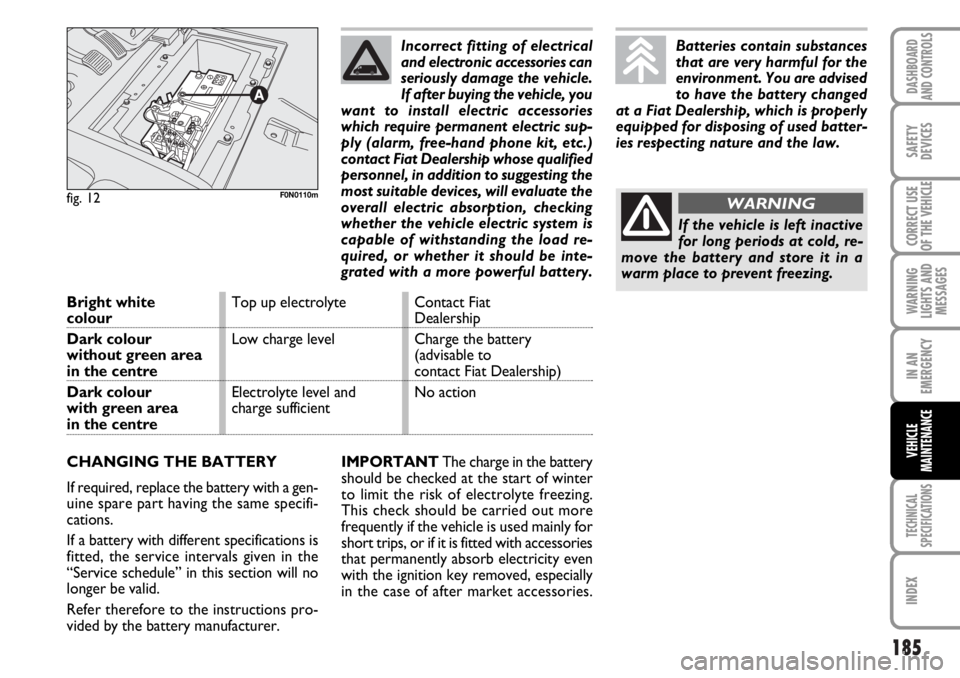
185
WARNING
LIGHTS AND
MESSAGES
TECHNICAL
SPECIFICATIONS
INDEX
DASHBOARD
AND CONTROLS
SAFETY
DEVICES
CORRECT USE
OF THE VEHICLE
IN AN
EMERGENCY
VEHICLE
MAINTENANCEIMPORTANTThe charge in the battery
should be checked at the start of winter
to limit the risk of electrolyte freezing.
This check should be carried out more
frequently if the vehicle is used mainly for
short trips, or if it is fitted with accessories
that permanently absorb electricity even
with the ignition key removed, especially
in the case of after market accessories.
fig. 12F0N0110m
Bright whiteTop up electrolyte Contact FiatcolourDealership
Dark colourLow charge level Charge the battery
without green area (advisable to
in the centrecontact Fiat Dealership)
Dark colour Electrolyte level and No action
with green area charge sufficient
in the centre
CHANGING THE BATTERY
If required, replace the battery with a gen-
uine spare part having the same specifi-
cations.
If a battery with different specifications is
fitted, the service intervals given in the
“Service schedule” in this section will no
longer be valid.
Refer therefore to the instructions pro-
vided by the battery manufacturer.Incorrect fitting of electrical
and electronic accessories can
seriously damage the vehicle.
If after buying the vehicle, you
want to install electric accessories
which require permanent electric sup-
ply (alarm, free-hand phone kit, etc.)
contact Fiat Dealership whose qualified
personnel, in addition to suggesting the
most suitable devices, will evaluate the
overall electric absorption, checking
whether the vehicle electric system is
capable of withstanding the load re-
quired, or whether it should be inte-
grated with a more powerful battery.
Batteries contain substances
that are very harmful for the
environment. You are advised
to have the battery changed
at a Fiat Dealership, which is properly
equipped for disposing of used batter-
ies respecting nature and the law.
If the vehicle is left inactive
for long periods at cold, re-
move the battery and store it in a
warm place to prevent freezing.
WARNING
Page 196 of 238
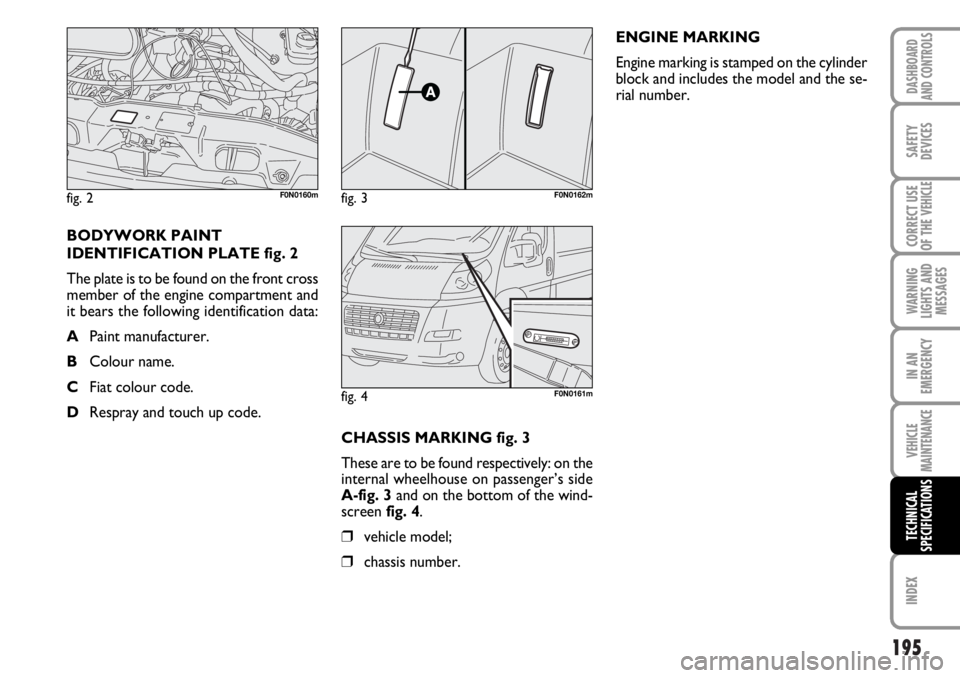
195
WARNING
LIGHTS AND
MESSAGES
INDEX
DASHBOARD
AND CONTROLS
SAFETY
DEVICES
CORRECT USE
OF THE
VEHICLE
IN AN
EMERGENCY
VEHICLE
MAINTENANCE
TECHNICAL
SPECIFICATIONS
CHASSIS MARKING fig. 3
These are to be found respectively: on the
internal wheelhouse on passenger’s side
A-fig. 3 and on the bottom of the wind-
screen fig. 4.
❒vehicle model;
❒chassis number.ENGINE MARKING
Engine marking is stamped on the cylinder
block and includes the model and the se-
rial number.
BODYWORK PAINT
IDENTIFICATION PLATE fig. 2
The plate is to be found on the front cross
member of the engine compartment and
it bears the following identification data:
APaint manufacturer.
BColour name.
CFiat colour code.
DRespray and touch up code.
fig. 2F0N0160mfig. 3F0N0162m
fig. 4F0N0161m
Page 199 of 238
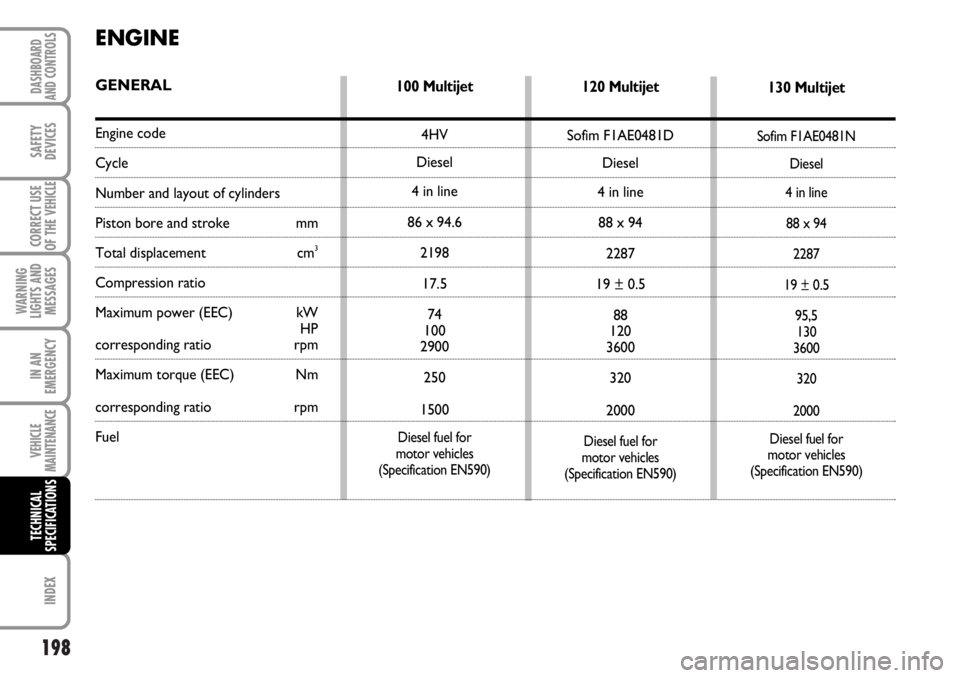
198
WARNING
LIGHTS AND
MESSAGES
INDEX
DASHBOARD
AND CONTROLS
SAFETY
DEVICES
CORRECT USE
OF THE
VEHICLE
IN AN
EMERGENCY
VEHICLE
MAINTENANCE
TECHNICAL
SPECIFICATIONS
ENGINE
GENERAL
Engine code
Cycle
Number and layout of cylinders
Piston bore and stroke mm
Total displacement cm3
Compression ratio
Maximum power (EEC) kW
HP
corresponding ratio rpm
Maximum torque (EEC) Nm
corresponding ratio rpm
Fuel
120 Multijet
Sofim F1AE0481D
Diesel
4 in line
88 x 94
2287
19 ± 0.5
88
120
3600
320
2000
Diesel fuel for
motor vehicles
(Specification EN590)
130 Multijet
Sofim F1AE0481N
Diesel
4 in line
88 x 94
2287
19 ± 0.5
95,5
130
3600
320
2000
Diesel fuel for
motor vehicles
(Specification EN590)
100 Multijet
4HV
Diesel
4 in line
86 x 94.6
2198
17.5
74
100
2900
250
1500
Diesel fuel for
motor vehicles
(Specification EN590)
Page 203 of 238

202
WARNING
LIGHTS AND
MESSAGES
INDEX
DASHBOARD
AND CONTROLS
SAFETY
DEVICES
CORRECT USE
OF THE
VEHICLE
IN AN
EMERGENCY
VEHICLE
MAINTENANCE
TECHNICAL
SPECIFICATIONS
UNDERSTANDING RIM
MARKING fig. 4
Example: 6J x 15 ET43
6,00 = rim width in inches 1.
J = rim drop centre outline (side
projection where the tyre bead
rests) 2.
15 = rim nominal diameter in inches
(corresponds to diameter of the
tyre to be mounted) 3= Ø.
ET43 = wheel camber angle (distance be-
tween the disc/rim supporting
plane and the wheel rim centre
line). Load rating (capacity)
70= 335 kg 81= 462 kg
71= 345 kg 82= 475 kg
72= 355 kg 83= 487 kg
73= 365 kg 84= 500 kg
74= 375 kg 85= 515 kg
75= 387 kg 86= 530 kg
76= 400 kg 87= 545 kg
77= 412 kg 88= 560 kg
78= 425 kg 89= 580 kg
79= 437 kg 90= 600 kg
80= 450 kg 91= 615 kg Maximum speed rating
Q = up to 160 km/h.
R = up to 170 km/h.
S = up to 180 km/h.
T = up to 190 km/h.
U = up to 200 km/h.
H = up to 210 km/h.
V = up to 240 km/h.
Maximum speed rating
for snow tyres
QM + S= up to 160 km/h.
TM + S= up to 190 km/h.
HM + S= up to 210 km/h.
Page 213 of 238
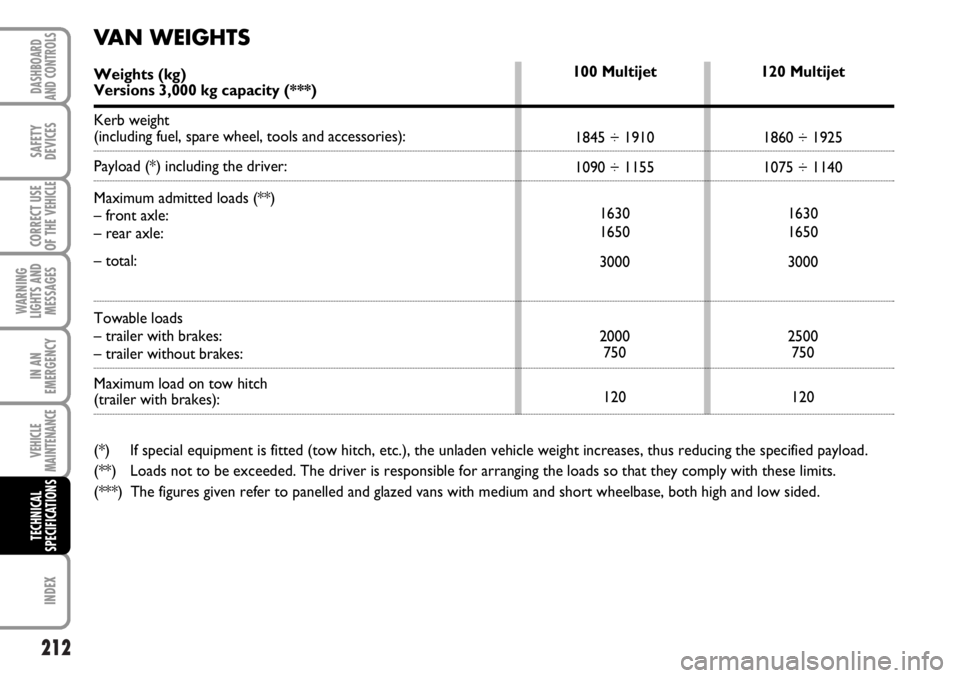
212
WARNING
LIGHTS AND
MESSAGES
INDEX
DASHBOARD
AND CONTROLS
SAFETY
DEVICES
CORRECT USE
OF THE
VEHICLE
IN AN
EMERGENCY
VEHICLE
MAINTENANCE
TECHNICAL
SPECIFICATIONS
120 Multijet
1860 ÷ 1925
1075 ÷ 1140
1630
1650
3000
2500
750
120 100 Multijet
1845 ÷ 1910
1090 ÷ 1155
1630
1650
3000
2000
750
120
VAN WEIGHTS
Weights (kg)Versions 3,000 kg capacity (***)
Kerb weight
(including fuel, spare wheel, tools and accessories):
Payload (*) including the driver:
Maximum admitted loads (**)
– front axle:
– rear axle:
– total:
Towable loads
– trailer with brakes:
– trailer without brakes:
Maximum load on tow hitch
(trailer with brakes):
(*) If special equipment is fitted (tow hitch, etc.), the unladen vehicle weight increases, thus reducing the specified payload.
(**) Loads not to be exceeded. The driver is responsible for arranging the loads so that they comply with these limits.
(***) The figures given refer to panelled and glazed vans with medium and short wheelbase, both high and low sided.
Page 214 of 238

213
WARNING
LIGHTS AND
MESSAGES
INDEX
DASHBOARD
AND CONTROLS
SAFETY
DEVICES
CORRECT USE
OF THE
VEHICLE
IN AN
EMERGENCY
VEHICLE
MAINTENANCE
TECHNICAL
SPECIFICATIONS
120 Multijet
1860 ÷ 2000
1300 ÷ 1440
1750
1900
3300
2500
750
120 100 Multijet
1845 ÷ 1985
1315 ÷ 1455
1750
1900
3300
2000
750
120
VAN WEIGHTS
Weights (kg)Versions 3,300 kg capacity (***)
Kerb weight
(including fuel, spare wheel, tools and accessories):
Payload (*) including the driver:
Maximum admitted loads (**)
– front axle:
– rear axle:
– total:
Towable loads
– trailer with brakes:
– trailer without brakes:
Maximum load on tow hitch
(trailer with brakes):
(*) If special equipment is fitted (tow hitch, etc.), the unladen vehicle weight increases, thus reducing the specified payload.
(**) Loads not to be exceeded. The driver is responsible for arranging the loads so that they comply with these limits.
(***) The figures given refer to panelled and glazed vans with medium and short wheelbase, both high and low sided.
Page 215 of 238
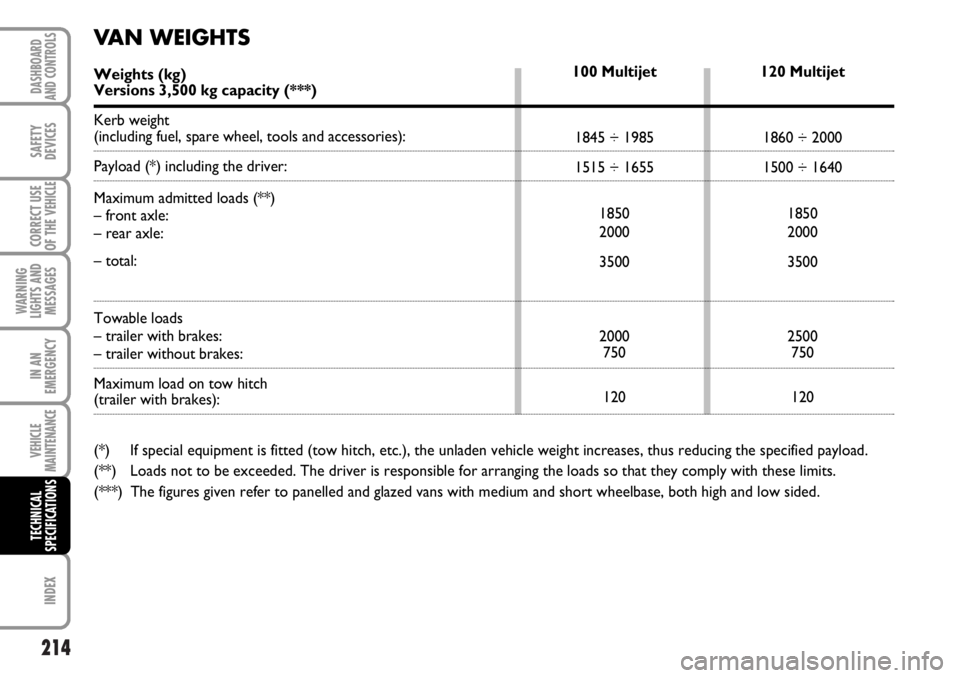
214
WARNING
LIGHTS AND
MESSAGES
INDEX
DASHBOARD
AND CONTROLS
SAFETY
DEVICES
CORRECT USE
OF THE
VEHICLE
IN AN
EMERGENCY
VEHICLE
MAINTENANCE
TECHNICAL
SPECIFICATIONS
120 Multijet
1860 ÷ 2000
1500 ÷ 1640
1850
2000
3500
2500
750
120 100 Multijet
1845 ÷ 1985
1515 ÷ 1655
1850
2000
3500
2000
750
120
VAN WEIGHTS
Weights (kg)Versions 3,500 kg capacity (***)
Kerb weight
(including fuel, spare wheel, tools and accessories):
Payload (*) including the driver:
Maximum admitted loads (**)
– front axle:
– rear axle:
– total:
Towable loads
– trailer with brakes:
– trailer without brakes:
Maximum load on tow hitch
(trailer with brakes):
(*) If special equipment is fitted (tow hitch, etc.), the unladen vehicle weight increases, thus reducing the specified payload.
(**) Loads not to be exceeded. The driver is responsible for arranging the loads so that they comply with these limits.
(***) The figures given refer to panelled and glazed vans with medium and short wheelbase, both high and low sided.
Page 216 of 238

215
WARNING
LIGHTS AND
MESSAGES
INDEX
DASHBOARD
AND CONTROLS
SAFETY
DEVICES
CORRECT USE
OF THE
VEHICLE
IN AN
EMERGENCY
VEHICLE
MAINTENANCE
TECHNICAL
SPECIFICATIONS
120 Multijet
1810 ÷ 1855
1125 ÷ 1145
1630
1650
2935/3000
2500
750
120 100 Multijet
1795 ÷ 1840
1125 ÷ 1160
1630
1650
2920/3000
2000
750
120
TRUCK BODY WEIGHTS
Weights (kg)Versions 3,000 kg capacity
Kerb weight
(including fuel, spare wheel, tools and accessories):
Payload (*) including the driver:
Maximum admitted loads (**)
– front axle:
– rear axle:
– total:
Towable loads
– trailer with brakes:
– trailer without brakes:
Maximum load on tow hitch
(trailer with brakes):
(*) If special equipment is fitted (tow hitch, etc.), the unladen vehicle weight increases, thus reducing the specified payload.
(**) Loads not to be exceeded. The driver is responsible for arranging the loads so that they comply with these limits.
Page 217 of 238
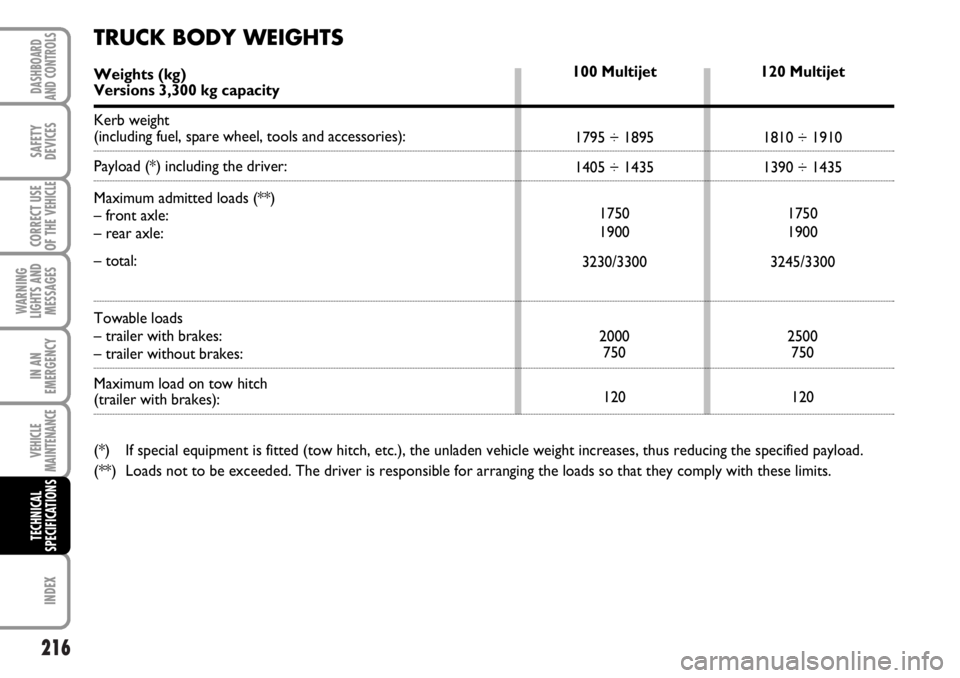
216
WARNING
LIGHTS AND
MESSAGES
INDEX
DASHBOARD
AND CONTROLS
SAFETY
DEVICES
CORRECT USE
OF THE
VEHICLE
IN AN
EMERGENCY
VEHICLE
MAINTENANCE
TECHNICAL
SPECIFICATIONS
120 Multijet
1810 ÷ 1910
1390 ÷ 1435
1750
1900
3245/3300
2500
750
120 100 Multijet
1795 ÷ 1895
1405 ÷ 1435
1750
1900
3230/3300
2000
750
120
TRUCK BODY WEIGHTS
Weights (kg)Versions 3,300 kg capacity
Kerb weight
(including fuel, spare wheel, tools and accessories):
Payload (*) including the driver:
Maximum admitted loads (**)
– front axle:
– rear axle:
– total:
Towable loads
– trailer with brakes:
– trailer without brakes:
Maximum load on tow hitch
(trailer with brakes):
(*) If special equipment is fitted (tow hitch, etc.), the unladen vehicle weight increases, thus reducing the specified payload.
(**) Loads not to be exceeded. The driver is responsible for arranging the loads so that they comply with these limits.
Page 218 of 238
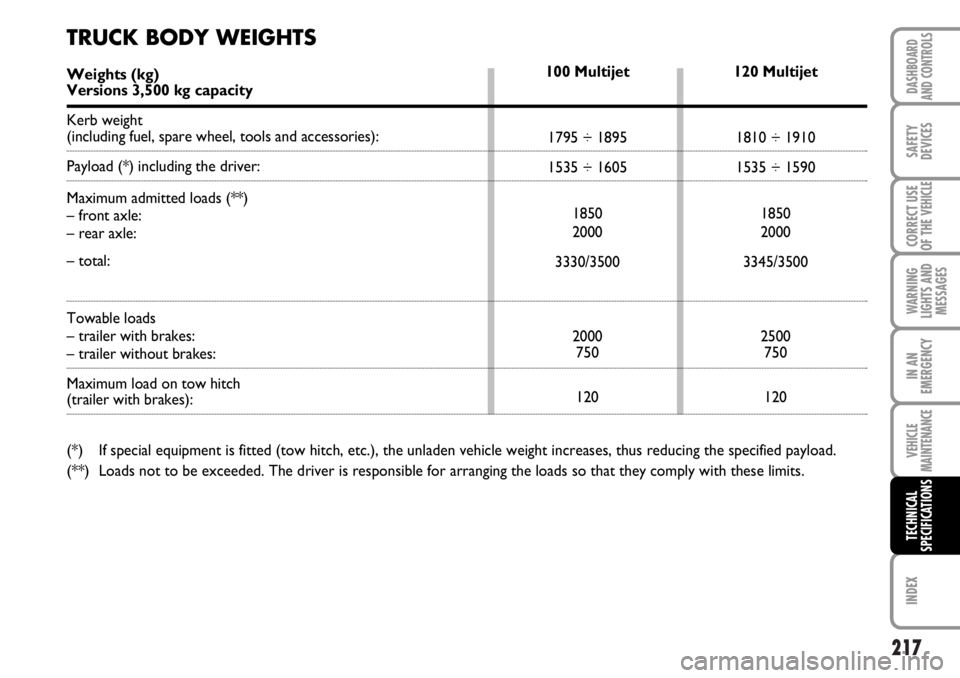
217
WARNING
LIGHTS AND
MESSAGES
INDEX
DASHBOARD
AND CONTROLS
SAFETY
DEVICES
CORRECT USE
OF THE
VEHICLE
IN AN
EMERGENCY
VEHICLE
MAINTENANCE
TECHNICAL
SPECIFICATIONS
120 Multijet
1810 ÷ 1910
1535 ÷ 1590
1850
2000
3345/3500
2500
750
120 100 Multijet
1795 ÷ 1895
1535 ÷ 1605
1850
2000
3330/3500
2000
750
120
TRUCK BODY WEIGHTS
Weights (kg)Versions 3,500 kg capacity
Kerb weight
(including fuel, spare wheel, tools and accessories):
Payload (*) including the driver:
Maximum admitted loads (**)
– front axle:
– rear axle:
– total:
Towable loads
– trailer with brakes:
– trailer without brakes:
Maximum load on tow hitch
(trailer with brakes):
(*) If special equipment is fitted (tow hitch, etc.), the unladen vehicle weight increases, thus reducing the specified payload.
(**) Loads not to be exceeded. The driver is responsible for arranging the loads so that they comply with these limits.